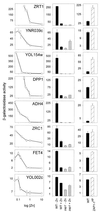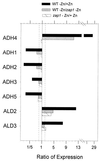Genome-wide characterization of the Zap1p zinc-responsive regulon in yeast
- PMID: 10884426
- PMCID: PMC16652
- DOI: 10.1073/pnas.97.14.7957
Genome-wide characterization of the Zap1p zinc-responsive regulon in yeast
Abstract
The Zap1p transcription factor senses cellular zinc status and increases expression of its target genes in response to zinc deficiency. Previously known Zap1p-regulated genes encode the Zrt1p, Zrt2p, and Zrt3p zinc transporter genes and Zap1p itself. To allow the characterization of additional genes in yeast important for zinc homeostasis, a systematic study of gene expression on the genome-wide scale was used to identify other Zap1p target genes. Using a combination of DNA microarrays and a computer-assisted analysis of shared motifs in the promoters of similarly regulated genes, we identified 46 genes that are potentially regulated by Zap1p. Zap1p-regulated expression of seven of these newly identified target genes was confirmed independently by using lacZ reporter fusions, suggesting that many of the remaining candidate genes are also Zap1p targets. Our studies demonstrate the efficacy of this combined approach to define the regulon of a specific eukaryotic transcription factor.
Figures




References
Publication types
MeSH terms
Substances
Grants and funding
LinkOut - more resources
Full Text Sources
Other Literature Sources
Molecular Biology Databases

